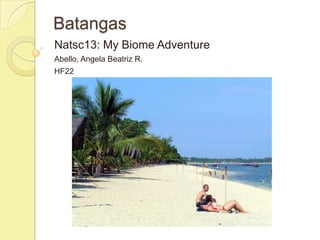
Batangas
- 1. Batangas Natsc13: My Biome Adventure Abello, Angela Beatriz R. HF22
- 3. My visit to Batangas
- 4. About Batangas Mean annual rainful is at maximum during July at 1.5 to 2.5 meters Dry Season from November to April and wet season for the rest of the year Animals: flying fox(Pteropus - flying foxes), Kabag(Pteropodidae), Marine turtle (Chelonioidea), Sea Slug (Onchidiidae) Plants: malabayabas, macastas, Anemone(Disambiguation),Bladderwarts (Utriculariasubulata)
- 5. Animals and Plants Flying fox: As the name suggests, the head resembles that of a small fox because of the small ears and large eyes. Females have one pair of mammae located in the chest region. Ears are simple (long and pointed) with the outer margin forming an unbroken ring (a defining characteristic of megabats). Toes have sharp curved claws. Kabag: Fruit bats are nocturnal, and hang from their feet during the day. They may hang with their wings wrapped around their bodies, or, if it is hot, may use their wings to fan themselves. Although fruit bats are good at flying, landing is another story! Fruit bats can't land gracefully, and instead must crash into bushes or trees to come to a stop, or try to latch onto a branch as they pass by. Sometimes these crash-landings disturb other fruit bats at the site, and cause noisy fights amongst them.
- 6. Sea turtles: almost always submerged in water, and, therefore, have developed an anaerobic system of respiration. Although all sea turtles breathe air, under dire circumstances they may divert to anaerobic respiration for long periods of time. When surfacing to breathe, a sea turtle can quickly refill its lungs with a single explosive exhalation and rapid inhalation. Their large lungs have adapted to permit rapid exchange of oxygen and to avoid trapping gases during deep dives. However, sea turtles must emerge while breeding, given the extra level of activity. Anemone: Many of the species are favorite garden plants, particularly since the different species can provide flowers throughout the year. Of the late spring bulbs, A. blanda is one of the most common, and is often sold as a mixture of colours, although purple predominates. The genus contains many other spring-flowering plants, of which A. hortensis and A. fulgens have less divided leaves and splendid rosy-purple or scarlet flowers. They require similar treatment. Sea slug: Onchidiidae are a family of small, air-breathing sea (and land) slugs. They are shell-less marine (except of 5 species)pulmonategastropod molluscs. Onchidiidae is the only family within the superfamilyOnchidioidea. Bladderworts: All bladderworts are rootless. They have main stems from which lacy, often complex leaves grow. Bladderwort flowers are usually bright yellow (but sometimes lavender, depending on species); the flowers have two "lip-like" petals of about equal size. Flowers are on long stalks that emerge several inches above the water. The carnivorous bladders are attached at regular intervals along the linear leaf segments.
- 7. Importance in my course I believe that knowing the biomes and everything about it, is important to my course since I would have to know the kind of animals and the plants that I can get there for ingredients I can use in the future.
- 8. Sources: http://en.wikipedia.org/wiki/Flying_fox http://en.wikipedia.org/wiki/Batangas http://www.thewildones.org/Animals/fruitBat.html http://en.wikipedia.org/wiki/Marine_turtle http://www.worldwildlife.org/species/finder/marineturtles/marineturtles.html http://www.batangastoday.com/carnivorous-plants-bladderworts-catches-prey-in-half-a-millisecond-video/10113/ http://www.dmr.state.ms.us/Coastal-Ecology/preserves/plants/insectivorous/bladderwort/bladderwort.htm